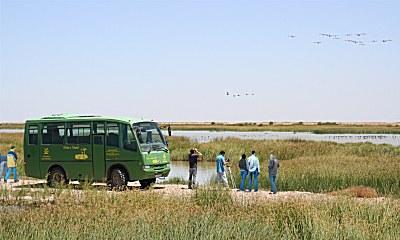Huelva, Andaluzia, Spain
Suggest Place to Visit
3751
Track to location with GPS |
 |
Doñana is a protected Natural Area located for the most part in the province of Huelva, in Andalusia (Spain).
The area of Doñana is spread over:
- The municipalities of Almonte, Moguer, Lucena del Puerto and Hinojos in the province of Huelva.
- Sanlúcar de Barrameda in the province of Cádiz.
- Pilas, Villamanrique de la Condesa, Aznalcázar, Isla Mayor and La Puebla del Río in the province of Seville.
Made up of the Doñana National Park and the Doñana Natural Park, its vast expanse of marshes is home to numerous species of aquatic birds during winter, making it one of the most interesting places for bird watching in Europe. Some 300 species visit Doñana at different times of the year, since it is a place of passage, breeding and wintering for thousands of them (aquatic and terrestrial) European and African.
With different scientific institutions within it that ensure proper development of the bordering regions and the conservation of some very delicate species that inhabit it, it is considered the largest Ecological Reserve in Europe and was declared a World Heritage Site by UNESCO in 1994 .
Its name comes from Doña Ana de Silva y Mendoza, daughter of the Princess of Éboli and wife of the VII Duke of Medina-Sidonia, who moved to a house located in the territory (Hunting Reserve), and from then on began to be called "Coto de Doña Ana", deriving later to the current term. This house was renovated years later, becoming a Palace.
It is used by the Presidents of the Government as a vacation spot.
Doñana has a mild Mediterranean-type climate. It is characterized by relatively wet winters and dry summers that are the result of polar front variations and high subtropical pressures. The rainiest seasons are the intermediate ones, in spring and especially in autumn there can be torrential rains caused by the accumulation of heat in the water masses during the summer, and the arrival of cold polar drops. In winter, however, thermal anticyclones may appear locally. Temperatures are mild throughout the year. The most significant of the climate is the three or five months of aridity in the summer, when it is under the dominion of the subtropical anticyclone.
Of the Flora highlights the great variety of species of:
- Trees, such as pine.
- Flowers, like the rose.
- Shrubs.
Species such as Vulpia fontquerana, Linaria tursica, Maritime Juniper, Micropyropsis tuberosa, Hydrocharis morsus ranae or Thorella verticillatinundata are of special interest, many of them threatened. In another sense, work is being carried out to eliminate non-native species such as Eucalyptus, Acacia, Gomphocarpus fruticosus, Nicotiana glauca or Cat's Claw.
Other notable species of the park, of the more than 900 that settle in the Doñana ecosystems are: the Oleander, the Cork oak, the Alhelí de Mar, the Almajo dulce, the Barrilla Pinchosa, the Barrón, the Brecina, the Heather, the Camarina, Cantueso, Sea Thistle, Carrizo, Clavellina, Enea, Common Fern, Jaguarzo, Junquera, Labiérnago, Lechetrezna del Mar, Lentisco, La Masiega, Palmito, Stone Pine, Retama Negra, Retama de Escobas, Rromero, Sabina, Gorse, Thyme, Torvisco or Blackberry. Also, there are flowering plants, like lavender.
The harshness of this ecosystem is evident in the need of some plant species to adapt to very special conditions such as sand dunes and their inconsistent soil. This ecosystem of mobile dunes, also known as Trenes de Dunas, is almost non-existent in other parts of the Iberian Peninsula as a consequence of the strong southwest wind. The burial of vegetation, and especially of trees that later emerge dead, by the slow movements of sand is one of the best known phenomena in the beach area in Doñana.
There are 20 species of Freshwater Fish, 11 Amphibians, 21 Reptiles, 37 Non-Marine Mammals and 360 Birds, of which 127 habitually reproduce in Doñana.
· Among the native fish, the Eel and introduced species such as Carp, Gambusia or Pike stand out, which are considered a threat to the conservation of ecosystems due to their invasive nature.
Reptiles and Amphibians such as: Western Cogulla Snake, Southern Smooth Snake, Blind Snake, Bastard Snake, Collared Snake, Viperine Snake, Gallipato, Carbonell's Lizard, Red-tailed Lizard, Ocellated Lizard, Common Frog, San Antonio Frog, Pintojo Sapillo , Common Toad, Runner Toad, Spurred Toad, Moorish Tortoise, Snout Viper, Iberian Newt, Spotted Newt, Common Gecko, European Pond, Common Chameleon.
Birds such as: Alcotán, Bee-eater, Hoopoe, Curlew, Mallard, Black-tailed Marlin, Imperial Eagle, Montagu's Harrier, Alcatraz, Lark, Long-eared Owl, Griffon Vulture, White Stork, Great Cormorant, Raven, Cuckoo, Spatula, Quail, Redstart , Black starling, Flamingo, Common Egret, Herring Gull, Purple Heron, Daurian Swallow, Screech Sparrow, Peregrine Falcon, Goldfinch, Country Owl, Kingfisher, Royal Kite, Mallard, Wood Pigeon, Robin, Charlo Thrush, Magpie, Common Swift , Common Greenfinch, Oropendola, Bastard Nightingale, Lugano, Mountain Bunting, among many others.
Mammals such as: Deer, Field Rabbit, European Hedgehog, Fallow Deer, Gineta, Wildcat, Wild Boar, Iberian Lynx, Careto Dormouse, Mongoose, Bat, Cave Bat, Large Horseshoe Bat, Buzzard Bat, Shrew, Otter, Mouse, Polecat, Fox, Badger, Small Noctulus, among others.
The Iberian Lynx is the most threatened feline on the planet. Restricted to the Iberian Peninsula, the drastic decrease in numbers has led to it being declared a Protected Species (1966) and to the only colonies of lynxes in the Sierra de Ándujar and Cardeña, Montoro, and Doñana Natural Parks. In Portugal, efforts are being made to recover its habitat, such as the Sierra de Malcata Nature Reserve.
The El Acebuche Breeding Center in Doñana develops a captive breeding program, in which it has achieved the survival of several specimens born in the center, plus some thirty captured in the park and whose possible survival was more than doubtful.
In Doñana there are also two breeds of autochthonous equidae, the Marismeño Horse and the Retuertas Horse, the latter is considered the oldest Wild Horse Breed in Europe.
Among the highlights are:
-The Acebrón Palace: it was built in the 60s by Luis Espinosa Fondevilla, who dedicated it as a place of private residence and hunting lodge. At present it works as the Park's Visitor Center. It has a wide and large facade to which a Stone Staircase gives access, flanked by two Lions of the same material. In front of the Palace, there is a pond lit by Baroque Lanterns. The entrance to the building has a spacious living room with frescoed ceilings, and a colossal fireplace. The floors are marble.
Phone: 959 506 162
Email: en.donana-cvacebron.cma@juntadeandalucia.es
Opening Hours: 9:00 - 15:00 and 16:00 - 19:00.
-Dunar de Matalascañas Park (Almonte) and Museum of the Marine World.
· The Dunar de Matalascañas Park is a new concept of tourist and recreational offer, based on the use and conservation of natural resources in the surroundings of Doñana, more specifically a space for the enjoyment of the Dune and the existing ecosystems.
From east to west and parallel to the beach, a large Fossil Dune rises that extends to Mazagón. This was formed due to two successive geological processes; First, the terrain rose, due to a fracture or fault located in the town of Matalascañas, exposing the fossil sediments of previous sandstones, and later recent aeolian sediments were deposited on those sandstones. These aeolian sediments were fixed in a natural way, due to the spontaneous colonization by native plants aided by the successive repopulations, which took place in the middle of the last century, carried out almost exclusively with Pine Pine, the dominant tree in Dunar Park, and in the entire Doñana Natural Area in general.
· Within the Dunar Park is the Museum of the Marine World, designed by the eminent architects Cruz and Ortiz imitating the shape of a dune. The highlight is the collection of 13 real Cetacean skeletons (largest exhibited in Spain). We can find a 20-meter whale (the second largest animal on the planet after the blue whale), in contrast we can also find the skeleton of a 1-meter-long porpoise (the smallest cetacean in the Atlantic Coast).
Phone: 959 448 409
Fax: 959 448 061
Email: mundomarino@museomundomarino.es
Opening Hours: Tuesday to Saturday: 11:00 - 14:30 / 18:00 - 21:30.
Rates:
7 years and under: Free (In private visit and accompanied by an adult).
Over 7 and under 14: € 3.60
Adults (15 to 65 years old): € 5.60
Over 65s: € 3.60
Special reductions for concerted groups, schoolchildren, entities, companies, retirees, conferences, etc.
Guided visits.
- El Acebuche Visitor Center is located in an old Cortijo and is the starting point for visits to the Park. It has Trails and Bird Observatories on the lagoon of the same name, in addition to being able to contemplate the daily life of the Iberian Lynxes that are in captivity.
Phone: 959 439 629
Email: en.donana-cvacebuche.cma@juntadeandalucia.es
Opening hours:
October to March: 8:00 a.m. - 7:00 p.m.
April to September: 8:00 a.m. - 9:00 p.m.
- Ice Factory Visitor Center is located in Sanlúcar de Barrameda, in an old Ice Factory from the beginning of the 20th century, in the Bajo de Guía Marine District. Designed for the Reception of Visitors to the Doñana National Park. Next to it is the Pier from which the Real Fernando Ship departs, a boat that takes visitors up the Guadalquivir River, to the town of La Plancha, where you can see Marismeñas Huts and from where you can access the Velázquez Llanos and the Llanos de la Plancha, where there are Observatories.
Phone: 956 386 577
Email: en.donana-cvfabricahielo.cma@juntadeandalucia.es
Opening Hours:
Summer 9:00 - 20: 00/21: 00 h
Winter: 9:00 a.m. - 7:00 p.m.
Royal Ship Fernando
Phone: 956 363 813
Fax: 956 362 196
Email: info@visitasdonana.com
Customer service hours:
April to October: from 9:00 a.m. to 8:00 p.m.
November to March: from 9:00 a.m. to 7:00 p.m.
Uninterrupted hours from Monday to Sunday (including holidays).
Collection of tickets in the same Ice Factory Visitor Center 30 minutes before the ship's departure. It is advisable to book in advance.
- Bajo de Guía Visitor Center is located in Sanlúcar de Barrameda, designed to receive Visitors to the Doñana Natural Park.
Phone: 956 380 922
Opening Hours:
October to May from 10:00 - 14:00.
At Easter, Holidays and Holiday Eves also from 16:00 - 18:00.
June to September from 10:00 - 14:00 and from 18:00 - 20:00.
Closed Monday
Comments
We don´t have yet any comments about:
Doñana National and Natural Park
Doñana National and Natural Park
Be the first to leave a comment as it is very important to inform other people
Outros locais a visitar
Within a radius of 20 km from:Doñana National and Natural Park
Franciscanos Frailes Menores Provincia de Granada Curia Provincial |
| 18,2 Km |
 |
Hotel reservation near Doñana National and Natural Park within a radius of 20 km
Why to book with ROTAS TURISTICAS
The best prices
Our partnerships with the world´s largest operators offer research on the best market prices.
More options
At Rotas Turisticos you can book the hotel, buy the air ticket, book the transfer from the airport to the hotel and vice versa, book the local excursions, rent the car, take travel insurance and consult the places to visit and where to go.
Holiday Tips & Destinations
Hundreds of holiday destinations with all the options that allow you to easily choose the destination that best suits your dream vacation.
ROTAS TURISTICAS
Links






